Intro to B2B eCommerce
B2B or business to business eCommerce is when one business sells and markets its products and services to another business via an online marketplace or channel. As with b2c or business to customer eCommerce retail, the main idea here is to reach a larger target market and process and fulfill orders in the most efficient way possible. From the buyer or the other business’s end, they are interested in finding transparent pricing and being able to place orders immediately and without intermediaries. At the end of the day, individuals who work in purchase and acquisitions are doing a job and wish to accomplish that job as quickly and easily as possible – b2b eCommerce facilitates this.
In this post I will talk about:
- The fundamental differences between b2b and b2c eCommerce.
- Major b2b market trends and statistics.
- How to grow your b2b eCommerce business with tried and true best practices.
- The advantages and disadvantages of b2b eCommerce.
How b2b eCommerce is different from b2c eCommerce?
Although b2b and b2c may seem similar they are actually quite distinct. Here’s how:
- Motivation for making a purchase – many b2c shoppers make purchases based on emotion and in many cases, it ends up being a one-time transaction. B2B buyers make much more rational purchase decisions based on metrics such as price and fulfillment time and are usually looking to cultivate long-term relationships with suppliers.
- Decision-making hierarchy – b2c purchases are usually made by an individual, couple or family whereas a b2b purchase may need to be approved by a board of directors or go through a series of approvals beyond the purchase & acquisition department.
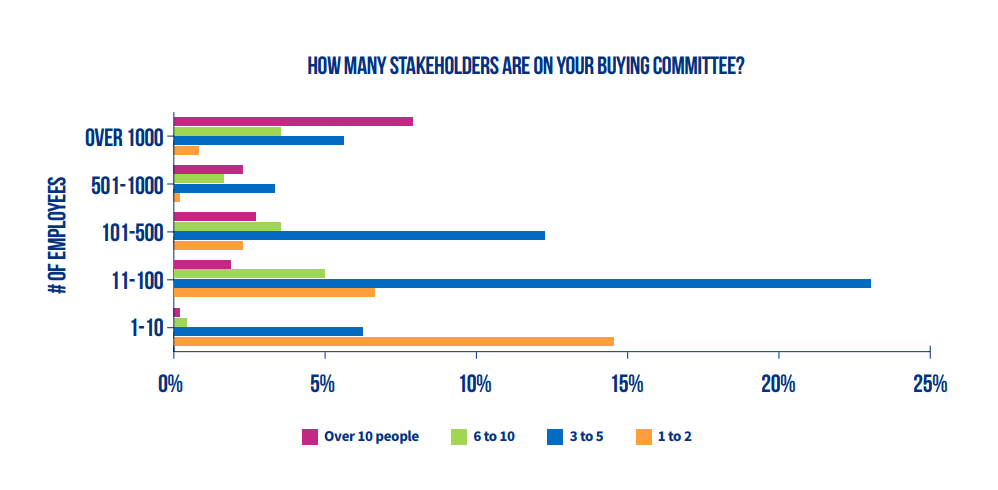
Source: How Generational Differences Impact B2B Buying Committees Today
- Pricing – since b2c customers are usually buying one item, they typically pay a set pre-determined price whereas b2b customers are generally looking to make large quantity purchases and will most likely be looking to negotiate a favorable deal based on the size of their order.
- Time of payment – B2C buyers typically pay for an item upon placing an order and before the item is even shipped out to them whereas b2b customers typically make a payment 30 days (or longer) after the goods are physically shipped out.
- Shipping – B2C customers typically make a purchase for personal use and as such speed of delivery can be a major deciding factor when placing an order. B2B customers are more interested in having their merchandise arrive on time based on a predetermined and agreed upon shipping and delivery schedule. Reliability trumps speed when it comes to b2b eCommerce.

B2B eCommerce Market Size and Statistics
If you are wondering whether or not it is worth your while to conduct b2b business on one eCommerce marketplace or another, have a look at the numbers and make an independent decision on where you think the b2b market is shifting.
B2B Ecommerce Market Trends
According to a report by Forrester the b2b eCommerce market will increase from its previous levels (2015) of 780 billion USD to 1.13 trillion USD in 2020. If these forecasts are correct then b2b eCommerce will make up 12.1% of the entire American b2b market which is estimated to be worth 9.39 trillion USD by 2020. The CAGR or Compound Annual Growth Rate of the b2b market was estimated at 7.7% annual growth which will stem from both buyers who are changing the channels on which they make purchases, presumably in search of greater convenience and efficiency and on the other hand by sellers who are on the lookout for ways to reduce costs to service customers.
If we look at the b2b eCommerce market from a global perspective, we can also see massive growth – in 2017 alone this market was worth 7.661 trillion USD which was 3 times the b2c market at the time.
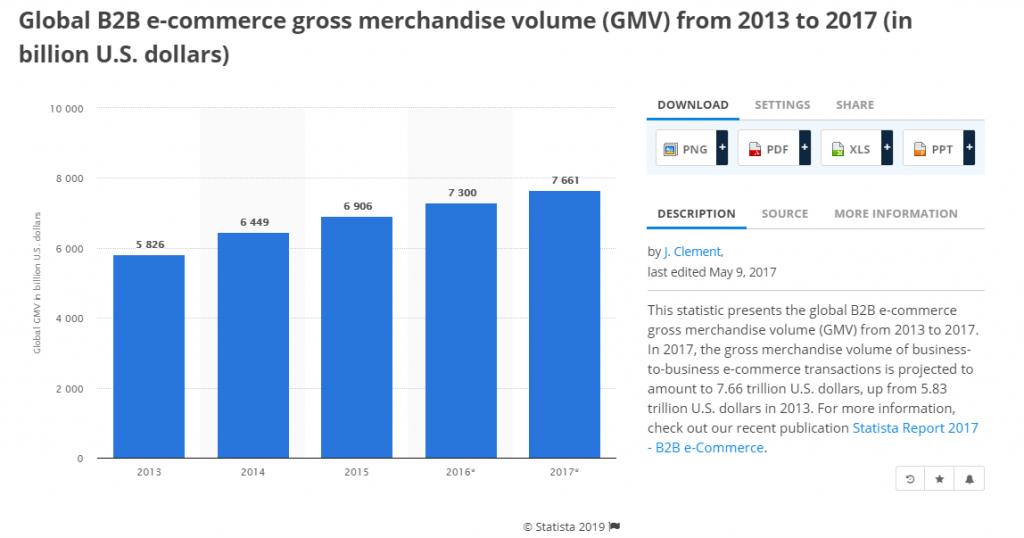
Source: Statista
Moving into 2018, the b2b eCommerce market was worth 10.6 trillion USD which translates into 5 times the b2c eCommerce market.

B2B Ecommerce Purchasing Trends
As millennials come into their own in the corporate world, knowing how to market and sell to millennials is of the utmost importance. Understanding where this generation prefers to make key purchases on the corporate level is paramount for b2b businesses who want to gain their trust and business.
Most millennials shop online as b2c customers in their private lives and as such, they expect to enjoy the comforts of b2c eCommerce in the capacity of their b2b purchasing positions (Source: The Future of Customer Engagement And Experience Report). This same report included two very interesting and relevant statistics:
- 72% of all eCommerce based b2b consumers desire independent, online access to their corporate purchases and supplier accounts.
- Scheduled deliveries are extremely important to 64% of all eCommerce based b2b customers.
These numbers strengthen the above point that millennials want and demand b2c comforts in b2b settings. In my professional opinion and based on these numbers, companies who do not provide the people with what they want will ultimately lose out on a large chunk of potential business.
A recent report entitled How Generational Differences Impact B2B Buying Committees Today actually shows how involved millennials are in b2b purchase decisions and processes at the corporate level. The findings show that 13% of millennials are in positions at companies that allow them to make purchasing decisions. 27% of millennials are in corporate positions which allow them to directly influence purchasing decisions and 38% are in a role responsible for researching purchase decisions made by their companies and corporations.
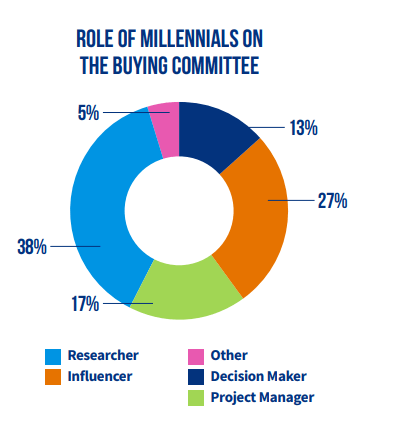
This same report reached the conclusion that b2b buying behaviors and patterns are increasingly mimicking those prevalent in the b2c market. This means that companies must first educate buyers, build trust-based relationships as well as communities around their product niche before making a sale is possible.
One last fact, according to The Changing Face of b2b Marketing by Kelsey Snyder, 89% of b2b purchase research is carried out via the internet and only after 12 searches will the researching party reach out to and engage with a business.
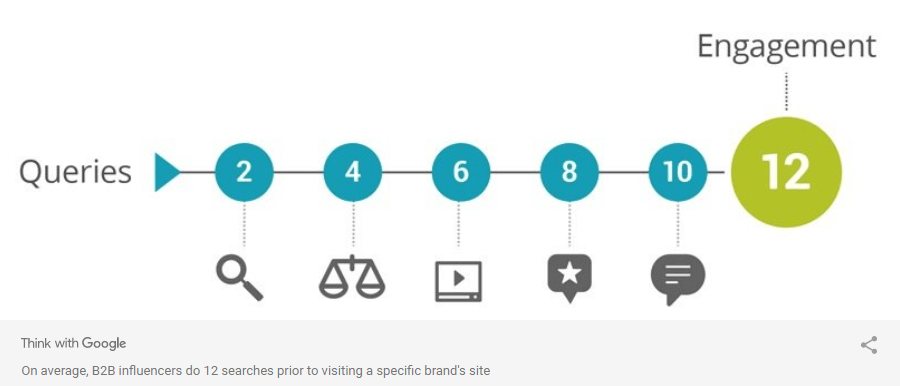
I think the data speaks for itself and the conclusion is clear:
Beyond survival, if you want to thrive in the b2b world of wholesale suppliers, you must have an online presence that caters to b2c wants and sensibilities.
B2B eCommerce Best Practices
Here are some b2b eCommerce best practices which will help you grow your b2b business:
- Offer a variety of unique discounts – Most b2b purchasers are used to and even expect a wholesale discount which you should of course offer. But beyond the industry standard try and think outside the box – how can I offer better rates and discounts while simultaneously motivating a customer to buy more from me on a regular basis? Special discounts which may set you apart from your competition may include:
- Holiday related discounts.
- Payments for merchandise 60 days after shipment instead of 30 which will give the company a cashflow incentive.
- Free personal samples and trials for the people in charge of purchasing as well as offering free additional quantities or higher discounts if a company buys more than two or three times in a row. Kind of like coffee shops who give you your tenth cup for free.
- You can also offer free delivery, free installment (if necessary/relevant), a company guarantee or even free customer support for an extended period of time.
- Think of customer success not support – You should aim that every purchase placed through your company gets fulfilled to the highest satisfaction of your customer. Failure to follow through on quantity or shipment commitments can cause the person who placed the order many problems on their end. By ensuring that you fulfill your commitments to them and by following up – you can ensure satisfaction and potentially enlist customers who will be loyal for years to come. Also, consider offering modern forms of support which may include online chat, email, Facebook messenger or even WhatsApp (personal anecdote: my gym offers 24/7 WhatsApp support and I think this is what I like most about them:))
- Be attentive and proactive with customer needs – You can do this either with an automated system or with a live representative. Most customers, b2b or otherwise appreciate having an attentive supplier or salesperson. This ‘attentiveness’ can have many forms such as:
- Suggesting products which are related to the items they are purchasing.
- Offering them creative ways in which to use or apply your goods or services.
- Suggestions that may help your customer save money on shipping such as splitting a shipment into two smaller orders in order to save on carrier costs or even taxes.
- Simplify and automate – People turn to online services in search of simplification. After doing a ton of research and finally deciding to make their purchase through you, you need to ensure that everything is as easy and simple as possible – from ordering to delivery and billing, you want as few barriers and as little customer friction as possible. Once they are happy with their first interaction with you, your new customers will want to be able to automate the entire process so that they waste as little time and effort as possible in terms of every repurchase. Consider working with professionals who can build a dedicated system or even an application that makes ordering from your company a breeze.
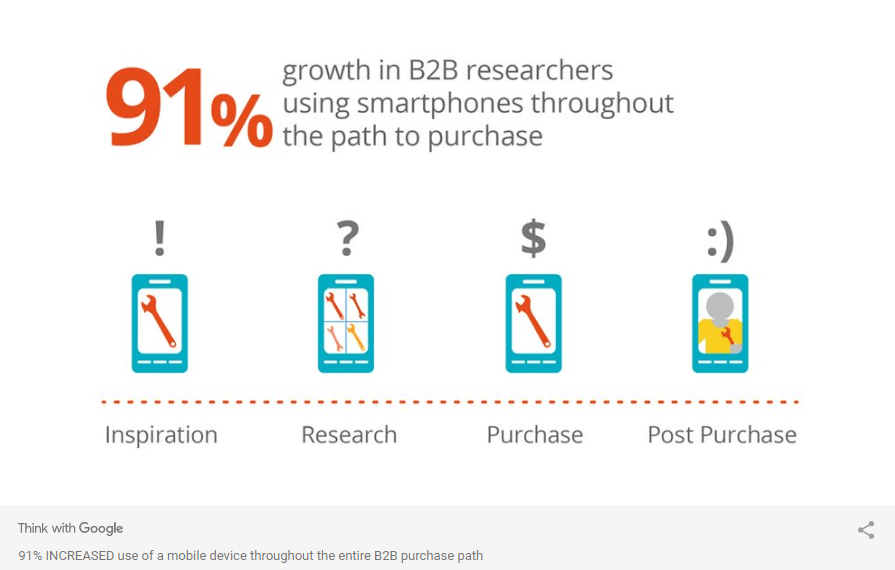
Advantages of b2b eCommerce
Here are some of the main advantages when engaging in b2b commerce on an online platform:
- Market stability – B2B eCommerce business models have more stability in terms of the market when compared with none internet-based models. B2B can be very complex, easily affected by local market conditions and all over hard to acquire new clients. When you add eCommerce b2b to the mix you are allowing yourself to diversify your revenue streams by opening your business up to new international clients who are affected and motivated by different markets. The end result is a more stable, less volatile customer base and revenue stream for your business.
- Increased sales – A b2b eCommerce approach usually leads to an increase in customer satisfaction as well as better management of supply chains. These two factors can easily lead to clients who have the potential to become loyal and long-term. Beyond this, many opportunities open up in which you can make your transaction with the other business more profitable – this may include up-selling and cross-selling tactics to increase your revenue stream from a given client or transaction.
- Decreased costs – When orders, supply chains and fulfillment for businesses move online there is usually a significant decrease in costs for all involved parties. This may include the employment of fewer representatives on both ends as well as a decrease in order, supply and shipment errors which can save millions in the long term. Once initial orders are placed, automation can also seriously and drastically reduce costs even further.
- Data-driven – All data generated by clients and transactions can and usually is saved for further analysis. When you have such a large database of real numbers on which to rely, it can be a business changing advantage as you can now forecast supply and demand to an extent, avoid previously unavoidable stock errors through inventory synchronization and even send clients automated restocking reminders based on your own data collection.
Disadvantages of b2b eCommerce
Here are some of the main disadvantages when engaging in b2b commerce on an online platform:
- Smaller market – Although this may sound counterintuitive since monetarily the above statistics show that the b2b market is larger than the b2c market, in practice, there are fewer customers in the b2b market than in the b2c market – just logically think about the fact that there are more customers than businesses on the market as whole. This fact may make it increasingly harder for you to get business and compete with larger b2b suppliers who may have more to offer or be able to provide people with more competitive prices.
- Lengthier process – When a company is familiar with you as a supplier for their company, it may take a while to get all the approvals needed despite the fact that they know you and your company. When beginning a business relationship with a company found online, the vetting process and due diligence required by the ordering party may take longer than anticipated. They may also ask for proof of inventory as well as other documentation to put their superiors at ease about ordering from a company that they have never heard of.
- It’s a buyer’s market – B2B is more of a buyer than a seller’s market meaning that especially when you are approached online by new potential customers, they will most likely reach out to multiple businesses and try to negotiate rock-bottom prices, ask you to customize certain items for free and dictate item specifications to you.
Summing it up
Despite some of the challenges that b2b commerce may pose, there is no question that it is the wave of the future and that any business that does not get on board soon will become obsolete in a matter of years. If you have not yet adapted your b2b model for eCommerce take your time to first make an action plan, perform meticulous market research and hire developers to build you a dedicated eCommerce platform and optimized mobile application. Take your time to really learn your market and competition and try to formulate a competitive offer with a clear call to action and personalized customer service order schemes.
Please comment below with one b2b eCommerce challenge or success which you have experienced recently!


